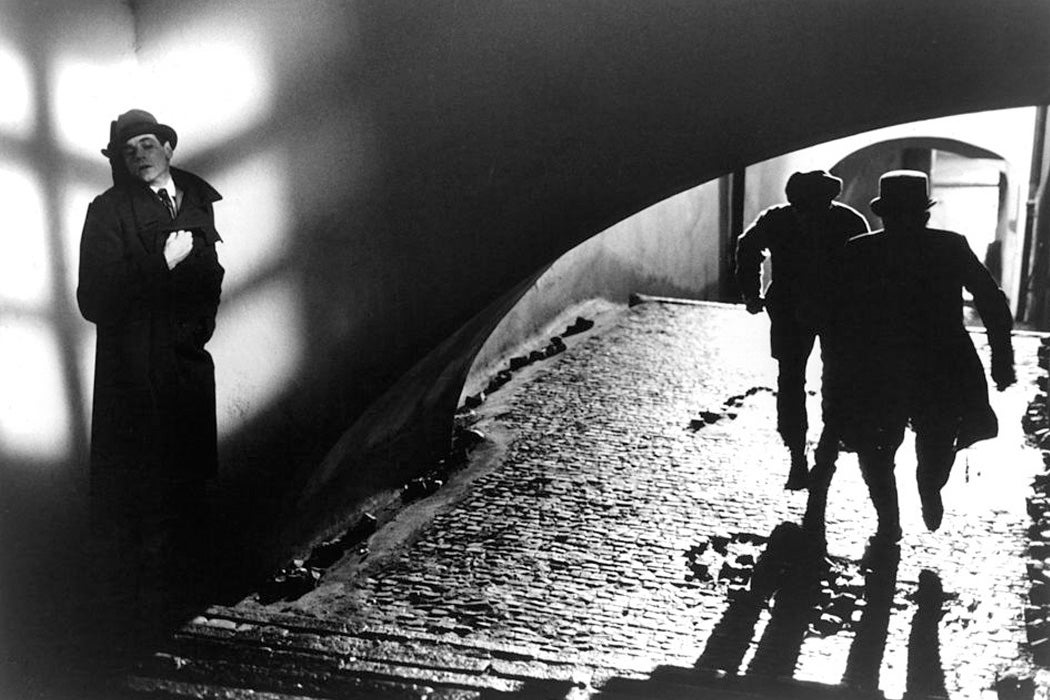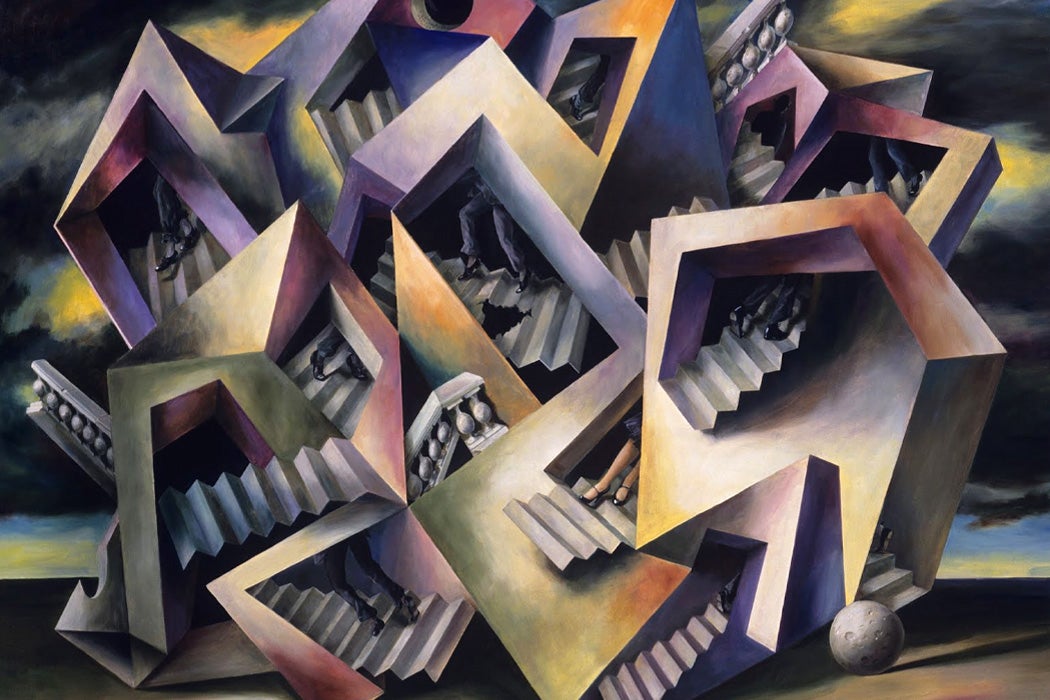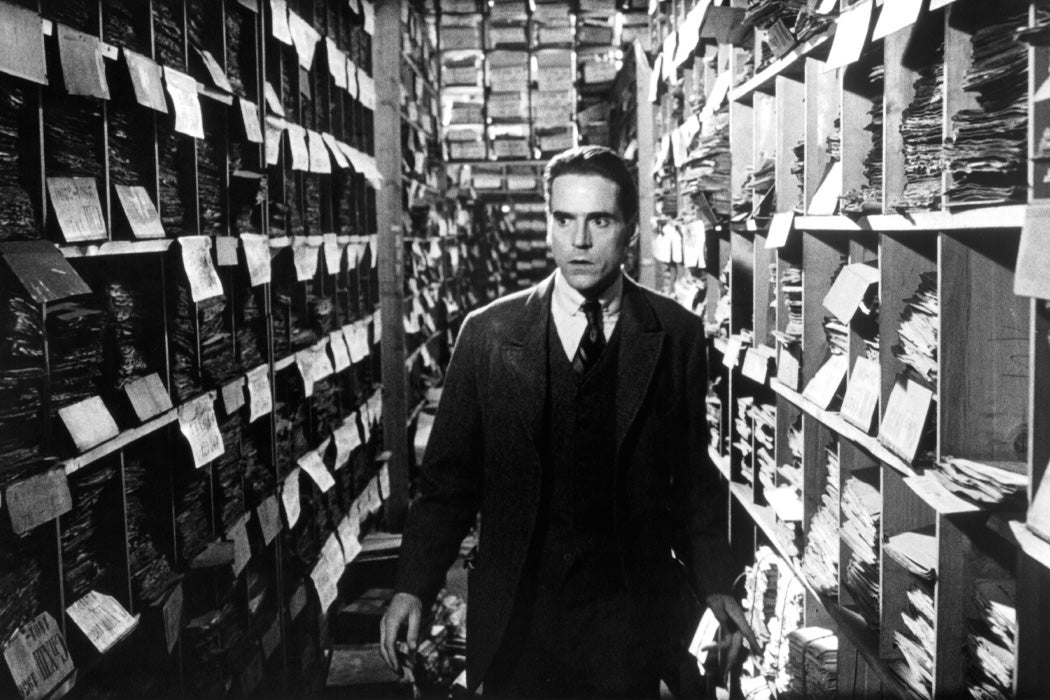In Franz Kafka’s novel The Trial, first published in 1925, a year after its author’s death, Josef K. is arrested, but can’t seem to find out what he’s accused of. As K. navigates a labyrinthine network of bureaucratic traps—a dark parody of the legal system—he keeps doing things that make him look guilty. Eventually his accusers decide he must be guilty, and he is summarily executed. As Kafka puts it in the second-to-last chapter, “The Cathedral:” “the proceedings gradually merge into the judgment.”
Kafka’s restrained prose—the secret ingredient that makes this story about a bank clerk navigating bureaucracy into an electrifying page-turner—trades on a kind of dramatic irony. As the novelist David Foster Wallace noted in his essay “Laughing with Kafka,” this is Kafka’s whole schtick, and it’s what makes him so funny. By withholding knowledge from the protagonist and the reader, Kafka dangles the promise that all will be revealed in the end. But with every sentence the reader takes in, it feels increasingly likely that the reason for K.’s arrest will remain a mystery.
As The Trial follows its tragic path deeper into K.’s insular, menacing, and sexualized world, it gradually becomes clear that the answer was never forthcoming. In fact, Kafka hints at the narrator’s ignorance at the very beginning: “Someone must have slandered Josef K., for one morning, without having done anything wrong, he was arrested.” Why the conjecture about what “must have” happened unless the narrator, who relates the story in the past tense, doesn’t know? That ignorance sets up the humor: During certain particularly insane moments in K.’s journey, the frustration of not knowing why he’s enduring it all becomes unbearable, at which point there’s no choice but to laugh.
Weekly Digest
Into the Unreal
Many commentators on The Trial have observed a sense of unreality in the novel, a feeling that something is somehow “off” that hangs like a fog over Kafka’s plotline. The philosopher Hannah Arendt, for instance, wrote in her well-known essay on Kafka: “In spite of the confirmation of more recent times that Kafka’s nightmare of a world was a real possibility whose actuality surpassed even the atrocities he describes, we still experience in reading his novels and stories a very definite feeling of unreality.” For Arendt, this impression of unreality derives from K.’s internalization of a vague feeling of guilt. That all-pervasive guilt becomes the means to secure K.’s participation in a corrupt legal system. She writes:
This feeling, of course, is based in the last instance on the fact that no man is free from guilt. And since K., a busy bank employee, has never had time to ponder such generalities, he is induced to explore certain unfamiliar regions of his ego. This in turn leads him into confusion, into mistaking the organized and wicked evil of the world surrounding him for some necessary expression of that general guiltiness…
In other words, Arendt reads The Trial as a kind of controlled descent into madness and corruption, ending in a violent exaggeration of the knowledge that nobody’s perfect.
The literary scholar Margaret Church expanded on these psychological themes in an article in Twentieth Century Literature, pointing to “the dreamlike quality of time values and the assumption of an interior time” employed throughout The Trial. According to Church, this unsteady temporality implies that most of what happens in The Trial isn’t real—or isn’t fully real, at any rate. In fact, she suggests, it makes as much sense to assume that “the characters are projections of K.’s mind.” Likewise, the literary scholar Keith Fort remarked in an article in The Sewanee Review that it’s “the nightmarish quality of unreality that has made Kafka’s name synonymous with any unreal, mysterious force which operates against man.” In other words, this type of unreality has become so closely associated with Kafka that the best word to describe it is, circularly, Kafkaesque.

License to Kafka
Writing in Critical Inquiry, however, the art historian Otto Karl Werckmeister charged that many Kafka interpreters, including Arendt, were engaging with a politicized fantasy of what Kafka represents, rather than with the real Kafka. For Werckmeister, this fantastical reading of Kafka’s life was best captured in Steven Soderbergh’s movie Kafka, which casts Jeremy Irons as “Kafka the brooding office clerk turned underworld agent”—a device that Werckmeister calls “Kafka 007” (after, of course, the James Bond franchise).
Some of these interpreters were motivated by a desire to dismiss Kafka as a handwringing bourgeois do-nothing—or even a “pre-fascist.” Others expressed a willingness to excuse Kafka’s alleged “indifference to social policy” by appealing to his loose associations with socialist or anarchist circles. All of them, Werckmeister argues, are missing the obvious: They underestimate Kafka’s role as a lawyer at the Worker’s Accident Insurance Institute, in Prague, where he imposed workplace safety regulations on unwilling industrial employers:
Thus at the highest echelons of a semipublic, government-sanctioned institution enacting social policy, Kafka’s job was to regulate the social conduct of employers vis-à-vis the working class… The employers under Kafka’s supervision tenaciously resisted the application of recent Austrian social policy laws, which were adapted from Bismarck’s legislation in Germany. They contested their risk classifications, disregarded their safety norms, tried to thwart plant inspections, and evade their premium payments. The department headed by Kafka was pitted against them in an adversarial relationship, no matter how conciliatory the agency’s mission was meant to be.
Kafka’s tales are a reflection of the deep obstacles to progress he perceived in the social reality of his time. He even “anticipated the political self-critique of literature to the point of its nonpublication,” keeping most of his writing private, then asking that the manuscripts for The Trial and The Castle be destroyed upon his death (a wish that was, thankfully, not honored). But the critical focus has been trained on the received version of Kafka, an interpretation of his life derived under exigent circumstances—the eruption of fascism in Europe—for ideological purposes. It has been trained, so to speak, on the Kafkaesque, instead of on Kafka himself.
For Werckmeister, it’s true that Kafka’s fiction ultimately offers the most reliable guide to his political orientation, provided we understand that fiction in the context of his professional life. At work, he took the side of the working class—indeed, he represented its interests in a struggle against capital. He was “a man who tried to live his life according to principles of humanism, ethics, even religion.” As a direct result of that experience, he learned the disturbing truth that, in the law, “Lies are made into a universal system,” as he wrote in the penultimate chapter of The Trial. The best he could manage within the law still would be a far cry from real justice (which, Kafka also knew, would have to include sexual justice to be anywhere near complete).
Maybe Werckmeister is right about the political motives of critics like Arendt, but what about the plunging sense of unease—like a feeling of falling—that no one can quite seem to shake when they first encounter Kafka’s stories?

“It’s Funny Because It’s True”
I’m here to suggest, following Werckmeister, that this feeling results from the fact that Kafka’s stories, despite their bizarre premises, are unnervingly real. Although there is undoubtedly an element of the absurd in the worlds Kafka creates, his style—unpretentious and specific, yet free from slang—renders those worlds with such painful accuracy that they seem totally familiar while we’re in them, like déjà vu or a memory of a bad dream:
K. turned to the stairs to find the room for the inquiry, but then paused as he saw three different staircases in the courtyard in addition to the first one; moreover, a small passage at the other end of the courtyard seemed to lead to a second courtyard. He was annoyed that they hadn’t described the location of the room more precisely; he was certainly being treated with strange carelessness or indifference, a point he intended to make loudly and clearly. Then he went up the first set of stairs after all, his mind playing with the memory of the remark the guard Willem had made that the court was attracted by guilt, from which it actually followed that the room for the inquiry would have to be located off whatever stairway K. chanced to choose.
The time-bending nature of Kafka’s prose, then, shouldn’t be seen as a pathological formalism—a linguistically engineered unreality—but as a reflection of Kafka’s intuitive understanding of the emerging principles of modern physics, in which time itself is relative.
A 1956 article by the renowned physicist Werner Heisenberg suggests that a high-level awareness of modern physics defines and structures the modernist sensibility in art. While “there is little ground for believing that the current world view of science has directly influenced the development of modern art,” still “the changes in the foundations of modern science are an indication of profound transformations in the fundamentals of our existence.” Now that the cat is out of Schrödinger’s bag (or rather, box):
The old compartmentalization of the world into an objective process in space and time, on the one hand, and the soul in which this process is mirrored, on the other… is no longer suitable as the starting point for the understanding of modern science. In the field of view of this science there appears above all the network of relations between man and nature, of the connections through which we as physical beings are dependent parts of nature and at the same time, as human beings, make them the object of our thought and actions.
The “unreality” in Kafka that has captivated so many commentators is what best aligns, ironically, with the current scientific worldview, which sees its own understanding of reality as necessarily partial, limited, and relative. If time in The Trial seems nonlinear, that’s only because the novel is so thoroughly modern; the uneven flow of time in the novel captures the dawning scientific realization that time is neither absolute nor universal.
Isn’t it, after all, the sense that Kafka—the voice on the page—is firmly in touch with reality that makes it feel acceptable to laugh at the deranged goings-on in The Trial? His jokes are technical achievements, yes, but they also speak to a feeling of loneliness that typifies the modern condition. Kafka himself couldn’t resist laughing when asked to read aloud from his work. To orchestrate this kind of laughter—to borrow a word from Wallace—might have offered relief from the relentless (and political) self-criticism that drove Kafka to conceal his writings. Kafka’s suppression of information gets us to let our emotional guard down. He contrives narrative tension so that he can shock us, confronting us anew with injustices to which we’ve become numb.







